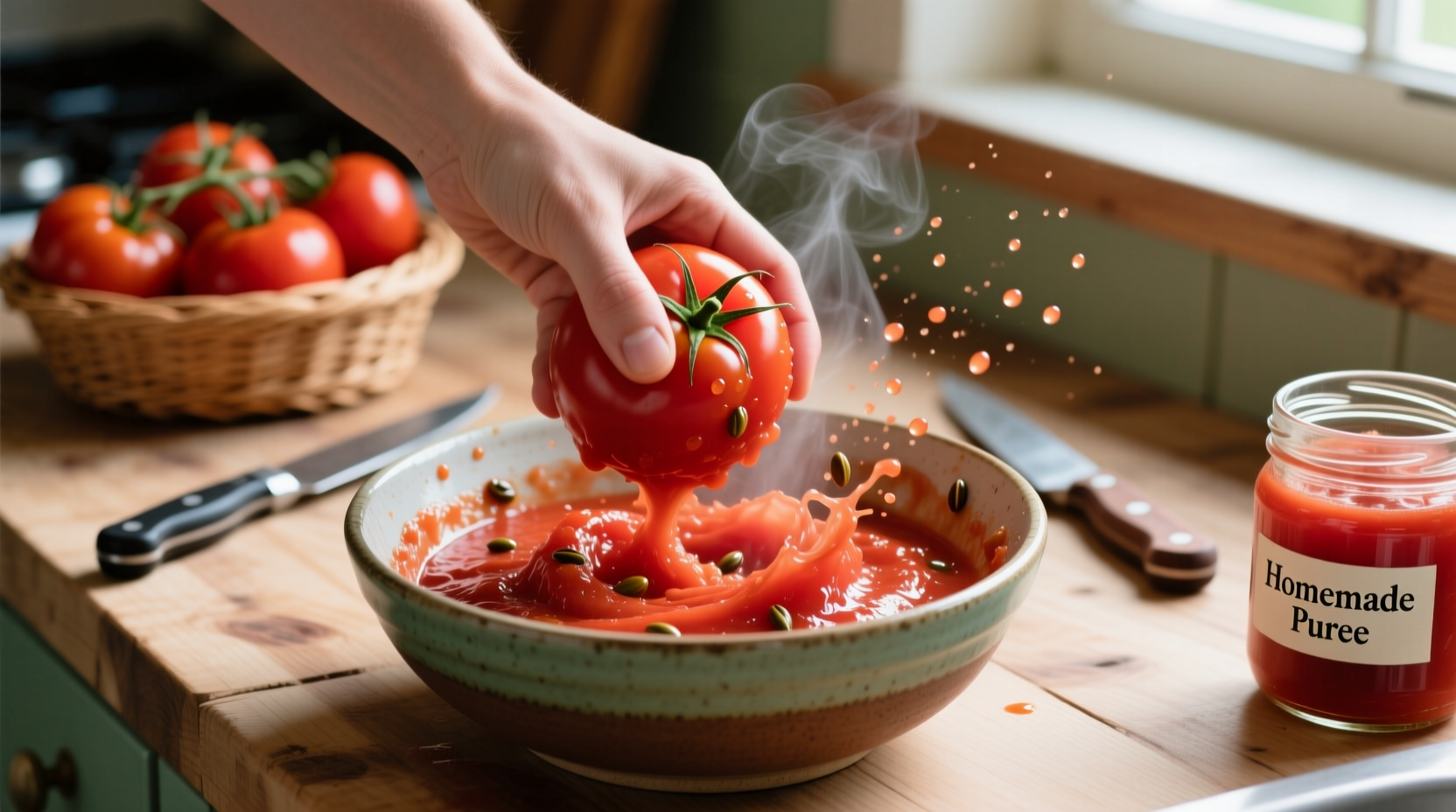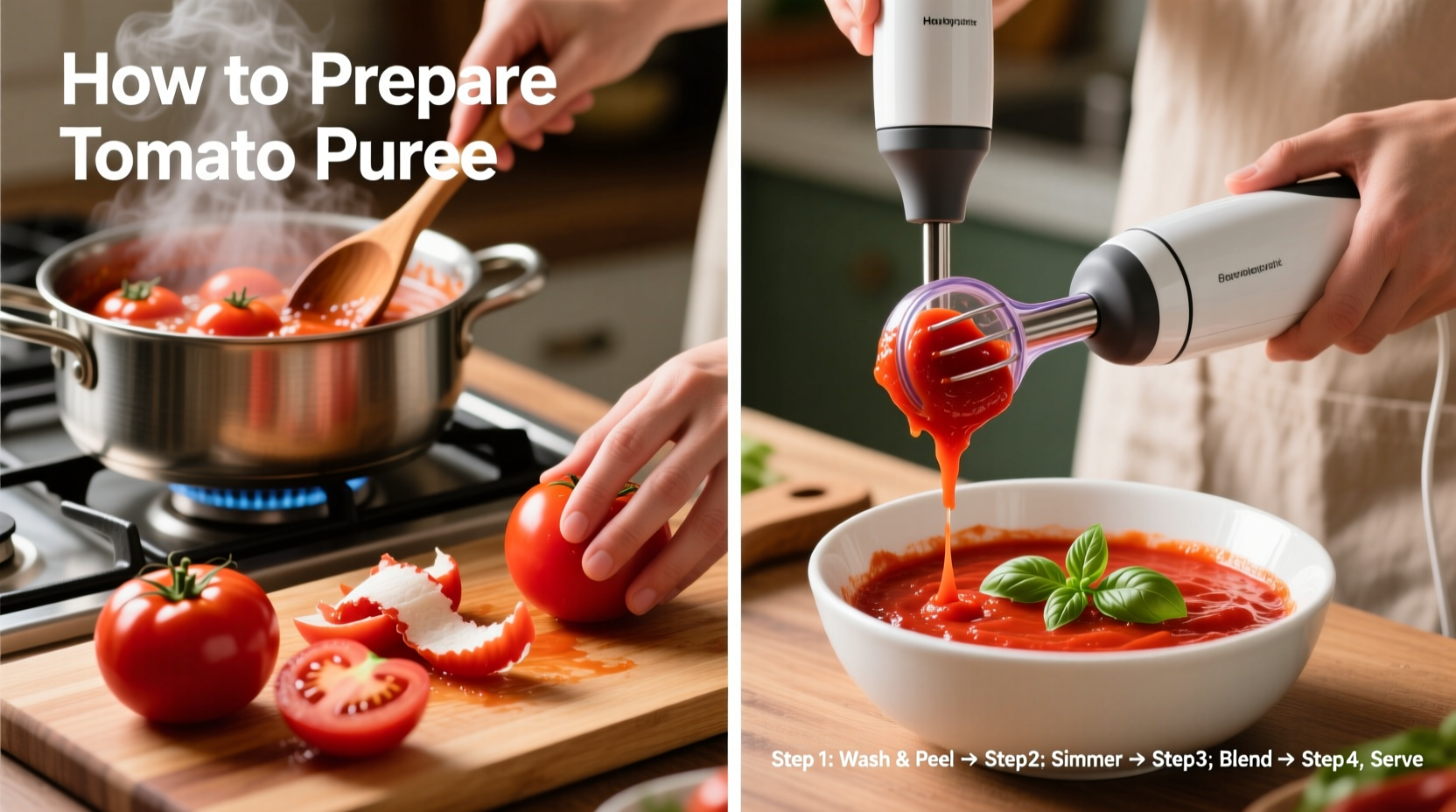The Complete Guide to Making Perfect Homemade Tomato Puree
Creating vibrant, flavorful tomato puree from scratch transforms your cooking with unmatched freshness and depth. Unlike canned alternatives loaded with preservatives, homemade puree captures summer's peak tomato flavor in a versatile base that elevates pasta sauces, soups, and stews. This guide walks you through the entire process with professional techniques refined over decades in restaurant kitchens.
Why Homemade Beats Store-Bought Every Time
Commercial tomato purees often contain citric acid, calcium chloride, and other additives to extend shelf life, compromising natural flavor. When you prepare tomato puree yourself, you control every element—selecting perfectly ripe tomatoes at their seasonal peak, adjusting acidity to taste, and preserving that just-picked freshness. The difference becomes immediately apparent in dishes where tomato flavor shines, like a simple marinara or fresh gazpacho.
Essential Equipment: Choose Your Method
Your equipment choice affects texture and efficiency. Professional kitchens typically use one of three approaches:
| Method | Best For | Texture Result | Time Required |
|---|---|---|---|
| Food Mill | Large batches, canning | Skin-seed free, velvety | 45-60 minutes |
| High-speed Blender | Small batches, immediate use | Slightly thicker, some fiber | 30-40 minutes |
| Immersion Blender | Direct pot blending | Rustic, textured | 35-45 minutes |
According to the USDA Food Safety and Inspection Service, proper equipment selection prevents cross-contamination and ensures safe food handling during preparation.
Selecting the Perfect Tomatoes
Not all tomatoes work equally well for puree. The ideal varieties balance acidity, sweetness, and flesh-to-liquid ratio:
- Roma (Plum) Tomatoes: The professional standard with thick flesh, fewer seeds, and concentrated flavor. Yields the thickest puree with minimal straining.
- San Marzano: Prized for sweet, complex flavor with lower acidity. Requires slightly longer cooking to reach ideal consistency.
- Vine-ripened varieties: Excellent flavor but higher water content means extended reduction time.
Avoid underripe tomatoes or varieties bred primarily for appearance rather than flavor, like many supermarket beefsteaks. The Rutgers New Jersey Agricultural Experiment Station confirms that Roma tomatoes contain 25% less water than standard varieties, making them ideal for puree production without excessive reduction.

Step-by-Step Preparation Process
1. Prep and Blanch (10 minutes)
Score an "X" on the bottom of each tomato. Submerge in boiling water for 30-60 seconds until skins loosen, then transfer to ice water. This thermal shock makes peeling effortless while preserving freshness.
2. Remove Skins and Seeds (Optional but Recommended)
Peel tomatoes starting from the "X." For ultra-smooth puree, cut tomatoes in half horizontally and squeeze out seeds over a bowl (reserve the liquid for soups). This step reduces bitterness from seed membranes.
3. Cook Down (20-30 minutes)
Place tomatoes in a heavy-bottomed pot over medium heat. Add 1 teaspoon salt per pound of tomatoes to enhance flavor extraction. Cook uncovered, stirring occasionally, until tomatoes break down completely and liquid reduces by half. For deeper flavor, add 1-2 torn basil leaves during cooking.
4. Puree to Perfection (5-10 minutes)
For food mill method: Ladle cooked tomatoes through food mill into clean bowl. For blender method: Cool slightly, then blend in batches until smooth. Never fill blender more than halfway with hot liquid to prevent accidents.
Troubleshooting Common Issues
Problem: Puree is too watery
Solution: Return to low heat and simmer uncovered, stirring frequently, until thickened to desired consistency. This typically takes 10-15 minutes.
Problem: Puree tastes too acidic
Solution: Balance with 1/4 teaspoon baking soda or 1 teaspoon sugar per cup of puree. Add gradually while tasting.
Problem: Separation occurs during storage
Solution: This is natural. Simply stir well before using. For long-term storage, ensure proper headspace in containers as recommended by the National Center for Home Food Preservation.
Storage Guidelines: Maximizing Freshness
Proper storage maintains quality and safety:
- Refrigeration: Store in airtight container for up to 5 days
- Freezing: Portion into ice cube trays, freeze solid, then transfer cubes to freezer bags (keeps 12 months)
- Canning: Process in water bath for 35-40 minutes following USDA guidelines for safe preservation
The National Center for Home Food Preservation emphasizes that proper acidification (pH below 4.6) is critical for safe canning. Add 1 tablespoon lemon juice per pint if using low-acid tomato varieties.
When to Use Tomato Puree vs. Other Tomato Products
Understanding context boundaries prevents recipe failures:
- Use puree when: You need a smooth base for sauces, soups, or stews where tomato flavor should shine without texture
- Choose crushed tomatoes when: You want visible tomato pieces in dishes like chili or rustic sauces
- Opt for paste when: You need concentrated tomato flavor to boost existing sauces without adding liquid
Professional chefs follow this hierarchy: paste for flavor concentration, puree for base applications, crushed for texture. Substituting incorrectly alters both texture and flavor balance in finished dishes.
Evolution of Tomato Puree Preparation
Tomato processing techniques have evolved significantly:
- Pre-1900s: Labor-intensive hand-mashing through cloth bags, requiring multiple passes to remove skins and seeds
- Early 1900s: Introduction of mechanical food mills revolutionized home processing, reducing preparation time by 60%
- 1950s: Electric blenders made smooth purees accessible to home cooks without specialized equipment
- Modern era: Precision temperature control and vacuum sealing extend shelf life while preserving fresh flavor
This progression reflects broader food technology advances documented by the Institute of Food Technologists, showing how kitchen innovations make professional techniques accessible to home cooks.
Professional Tips for Flavor Enhancement
Elevate your puree with these chef-tested techniques:
- Add 1 small finely diced carrot during cooking to naturally balance acidity without sweetness
- Include 1-2 sprigs of fresh oregano while simmering for Mediterranean depth
- For umami boost, stir in 1 finely minced anchovy (dissolves completely during cooking)
- Cool puree rapidly in an ice bath to preserve vibrant color and fresh flavor
Common Questions About Tomato Puree
How long does homemade tomato puree last in the refrigerator?
Properly stored in an airtight container, homemade tomato puree stays fresh for 4-5 days in the refrigerator. Always use a clean spoon when scooping to prevent contamination. For longer storage, freeze in portion-sized containers.
Can I make tomato puree without peeling the tomatoes?
Yes, though the texture will be slightly grainier with skin fragments. High-speed blenders can break down skins completely, but food mills will catch them. For smooth sauces like pizza sauce, peeling is recommended. For heartier dishes like vegetable soup, unpeeled works fine.
Why does my tomato puree separate when stored?
Separation occurs naturally as pectin breaks down over time. This is completely normal and doesn't indicate spoilage. Simply stir well before using. To minimize separation, cool puree rapidly after cooking and store in containers with minimal headspace.
Can I use green tomatoes to make puree?
Green tomatoes work but yield a more acidic, less sweet puree. They require additional sugar (1-2 tablespoons per pound) to balance flavor. Green tomato puree works well in chutneys or as a base for tart sauces, but doesn't substitute well in recipes expecting ripe tomato sweetness.
How do I adjust the consistency of my tomato puree?
For thicker puree, simmer uncovered to evaporate excess liquid. For thinner consistency, add reserved tomato liquid or water 1 tablespoon at a time while blending. The ideal puree should coat the back of a spoon but still flow slowly when tilted.











 浙公网安备
33010002000092号
浙公网安备
33010002000092号 浙B2-20120091-4
浙B2-20120091-4